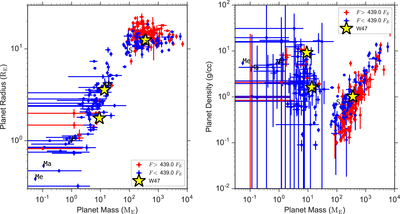Image Details

Caption: Figure 9.
Left: planet radius vs. mass for exoplanets with measured masses and radii, as determined by querying exoplanets.org on 2017 February 19 and including radii and masses from Hadden & Lithwick (2016) and Gillon et al. (2017). The sample is divided into those that receive more than the median incident flux (﹩F\gt 482{F}_{\oplus }﹩, red points) and those that receive less than the median incident flux (﹩F\lt 482{F}_{\oplus }﹩, blue points). The solar system planets are labeled. The WASP-47 planets are shown (yellow stars, the mass, and radius error bars are smaller than the symbols). The sub-Neptunes WASP-47 e and d are high-density for their size. WASP-47 b is a typical-sized hot Jupiter for its mass and incident flux.
Copyright and Terms & Conditions
© 2017. The American Astronomical Society. All rights reserved.












